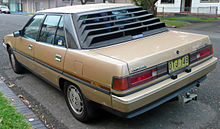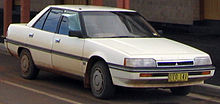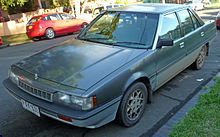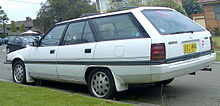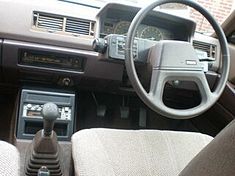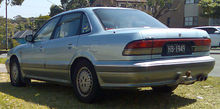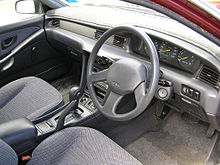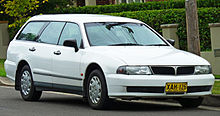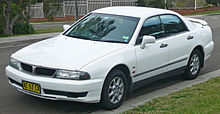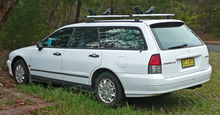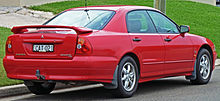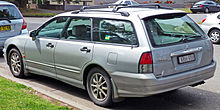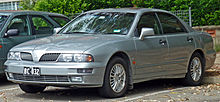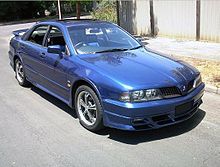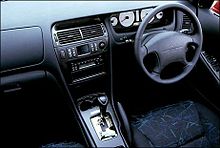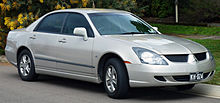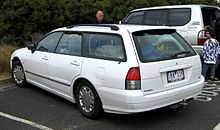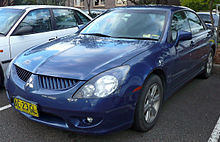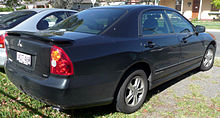- Mitsubishi Magna
-
Mitsubishi Magna 
Manufacturer Mitsubishi Motors Australia Production 1985–2005 Successor Mitsubishi 380 Class Mid-size car The Mitsubishi Magna was a mid-size car offered between May 1985 and September 2005 by Mitsubishi Motors Australia Limited (MMAL). Manufactured at the Tonsley Park assembly plant, Magna spanned three generations before being replaced by the Mitsubishi 380. Their 4-cylinder ("4G54/Astron II") and V6 ("6G72" and "6G74") engines were also manufactured by MMAL in South Australia, at the Lonsdale plant.
Prior to Magna, Mitsubishi did have a large family car to rival the Ford Falcon and Holden Commodore in the form of the 6-cylinder Chrysler Valiant, which was inherited upon MMAL's takeover of Chrysler Australia's operations in 1980. Nevertheless, the Valiant was put out of production the following year, making the Sigma MMAL's largest offering.
When Sigma's replacement became due, MMAL opined that a car's width was a crucial factor to Australian drivers who have traditionally favoured large cars. As a result, to compete more effectively against the large-sized Ford Falcon and Holden Commodore, former Chrysler engineers now working for MMAL, developed a wider mid-sized car specific for the Australian market. They accomplished this by splicing an extra 6.6 cm (2.6") right down the middle of Japan's mid-sized Mitsubishi Galant sedan, to create the unique Mitsubishi Magna range. Given the inherent space efficiency of front wheel drive (FWD) relative to rear wheel drive (RWD) platforms, this allowed MMAL to offer a passenger cabin that was as spacious, if not more spacious, than that of the market-dominant Ford Falcon and Holden Commodore.
Over the years, Magna grew in size and offered V6 power and All-Wheel-Drive (AWD), the latter to compete against its rivals' perception of better dynamics from RWD. The Magna was the first all-new Australian made Mitsubishi vehicle, replaced by the FWD Mitsubishi 380 sedan, which became the second and last of Australian made Mitsubishi car, upon MMAL's closure of its South Australian production facilities in 2008.
Contents
First generation (1985–1991)
First generation 
Also called Mitsubishi V3000 Production May 1985 – March 1991 Body style 4-door sedan
5-door station wagonEngine 2.6 L 4G54/Astron II I4 Transmission 4-speed automatic
5-speed manualWheelbase 2,600 mm (100 in) Length 4,600 mm (180 in) ('85–86)
4,620 mm (182 in) ('87–91)
4,723 mm (185.9 in) (wagon)Width 1,760 mm (69 in) ('85–86)
1,765 mm (69.5 in) ('87–91)Height 1,400 mm (55 in) ('85–86)
1,396 mm (55.0 in) ('87–91)
1,486 mm (58.5 in) (wagon)Curb weight 1193–1265 kg (2630–2789 lb) ('85–86) 1211–1321 kg (2670–2912 lb) ('87–91)
1247–1420 kg (2749–3131 lb) (wagon)Related Mitsubishi Galant The 1985 TM Magna was initially available only as a sedan. An Australian developed station wagon was released in 1987 with the updated TN series, proving popular with company fleets.
While the general styling and side profile was similar to the Japanese market Mitsubishi Galant of the time, the Magna was several centimetres wider in order to accommodate Australian market requirements. The smaller footprint at no expense of interior space also meant that Magna could get away with a big-bore 4-cylinder engine, instead of the more traditional 6-cylinder engines of its rivals. Fuel efficiency, however, was not significantly better.
The Magna range was FWD and formed by: GLX (intended for company fleets), Executive, SE and Elite. In later years, the range expanded to include a sporty Elante and Grand Tourer (both featuring bodykits), as well as several limited editions.
Their engine was an Australian-made single overhead cam (SOHC) transversely mounted 2.6-Litre Astron II 4-cylinder 8-valve engine codenamed "4G54", which was derived from the "4G52/Astron" of the preceding RWD Mitsubishi Sigma. It produced 85 kW (114 hp) at 5000 rpm and 198 N·m (146 ft·lb) at 3000 rpm.
This new "Astron II" engine featured hydraulic mounts and counter-balancing shafts (technology adopted by, amongst others, Porsche, for their large 4-cylinder 924-944-968 models) to reduce vibrations, characteristic of large 4-cylinder engines. Initially, these Australian engines were carburetted, with Mitsubishi's "ECI Multi" electronic Fuel injection (EFI) version launched in May 1989.
Fuel consumption on average for all models was 11.0 L/100 km in city driving and 7.8 L/100 km in highway driving, as measured according to the applicable Australian Standard.
Magna was fitted with either a 5-speed manual or a 4-speed automatic with overdrive (its button on the front of the shift lever, providing a 3-speed or 4-speed mode), with the luxury Elite available only in automatic. In terms of suspension, the car featured McPherson strut independent front design and at the rear a 3 link torsion beam axle with coil springs. The wagons ran a 4 link beam axle with coil springs.
The more luxury-oriented models - SE and Elite - featured higher equipments: seats were covered in velour trim with the driver's seat being multi-adjustable; rear passengers benefitted from integrated headrests; automatic transmission (standard on Elite), power windows, central locking, alloy wheels and metallic paint standard on Elite (two-tone paint) and optional on SE (one-tone paint); radio radio/cassette players were equipped with a roof mounted telescopic antenna and novel security system that would make the unit completely inoperable in the event that its power was disconnected, while Elite's system also featured a separate equalizer and controls buttons on its steering. In addition, instead of standard control steering stalks and air conditioning panel on their dashboards, SE and Elite had two steering side pods, thus bringing all major controls within a driver's fingertips (not dissimilar to the new supercar trend pioneered by the Ferrari 458 of 2010), and making them jointly height adjustable with the steering column. Finally, Elite also featured an LCD instrument panel, thanks to the Japanese automotive trend in the late 1980s.
As has been the case with all-new generations of Australian cars (e.g. Holden Camira, Ford EA Falcon, Holden VT Commodore) the first range TM Magna was marred by various quality-control problems (chiefly: fragile engine heads and automatic transmissions), which were eventually rectified throughout the life of this 1st-generation Magna. At launch, however, this car was voted Wheels magazine's 1985 Car of the Year.
The TP wagon remained on sale alongside the new 2nd-generation TR-series Magna for a period, being run-out as the Safari limited edition model until the arrival of the TR wagon models.
TM (1985–1987; sedan-only)
- GLX (carbureted; manual and automatic)
- Executive (carbureted; manual and automatic)
- SE (carbureted; manual and automatic)
- Elite (carbureted; automatic)
TN (1987–1989)
- GLX (carbureted and EFI; manual and automatic)
- Executive (carbureted and EFI; automatic)
- SE (carbureted and EFI; manual and automatic)
- Challenge wagon (carbureted and EFI; manual and automatic)
- Elite (EFI; automatic)
- Elante sedan (EFI; manual and automatic)
TP (1989–1991)
- GLX (carbureted and EFI; manual and automatic)
- Executive (carbureted and EFI; manual and automatic)
- SE (EFI; manual and automatic)
- Elite (EFI; automatic)
- Elante sedan (EFI; manual and automatic)
- Grand Tourer (EFI; manual and automatic)
- Executive Safari wagon (EFI; manual and automatic)
Second generation (1991–1996)
Second generation (TR, TS) 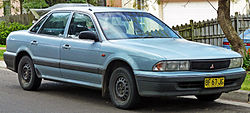 1991–1994 TR Magna GLX
1991–1994 TR Magna GLXAlso called Mitsubishi Diamante
Mitsubishi Sigma
Mitsubishi VeradaProduction April 1991 – March 1996 Body style 4-door sedan
5-door station wagonEngine 2.6-Litre 4G54/Astron II I4
3.0-Litre 6G72 V6Transmission 4-speed automatic
5-speed manualWheelbase 2,722 mm (107.2 in) Length 4,746 mm (186.9 in) Width 1,775 mm (69.9 in) Height 1,430 mm (56.3 in) Curb weight 1,356 kg (2,989 lb) TR
Magna was reengineered from the ground-up in 1991, with the introduction of a larger sedan and wagon based on the Japanese Mitsubishi Diamante and Sigma hardtop. Unlike its Japanese cousins, the 2nd-generation Magna featured conventional B-pillars and suspensions designs as well as no advanced electronics.
Despite this, the Australian-made TR Magna range was designed to be exported and its build quality reflected this engineering intent. Indeed, for the first time With this new generation Magna, for the first time in its history, MMAL created a 2-tier luxury range, called the Verada Ei and Xi. Both Magna and Verada shared the same body, however, the latter featured larger bumper bars to meet export market safety standards, and more luxury fittings including electronic suspension control on the top of the range Verada Xi.
TR Magna was more powerful than its predecessor, notwithstanding carrying over the venerable "Astron II" engine - this time reworked and fitted with EFI. This was across the range except for the base model GLX, which remained carbureted (for a lower retail price to again appeal to company fleets; re-introduced for duty sometime after the original launch of the TR range). While Australia continued to endure the early 1990s recession, MMAL's ambitions to battle against Ford and Holden with a 6-cylinder Magna remained on hold.
Finally, in 1993, with the economy recovering and oil prices restabilised after the Gulf War, a V6 engine was indeed offered on Magna for the first time in its history - albeit as an option.
The V6 was effectively the same unit that had powered the luxury KR Verada range since late 1991. Both TR/KR's Astron II and V6 were engineered to run on either normal or premium unleaded fuel, with the respective power and torque outputs on either fuel being: 98 kW (131 hp) at 4750 rpm / 212 N·m (156 ft·lb) at 3750 rpm or *102 kW (137 hp) at 4750 rpm / 220 N·m (160 ft·lb) at 4000 rpm for the 4-cylinder; 120 kW (160 hp) at 5500 rpm / 235 N·m (173 ft·lb) at 4000 rpm or 124 kW (166 hp) at 5500 rpm / 244 N·m (180 ft·lb) at 3000 rpm for the V6.
TS
All models were facelifted in March 1994, thus creating the new TS Magna and KS Verada. Their respective engines were further upgraded, while Verada benefitted from extra for-export fittings such as more distinctive front grille and multi-parabola headlights (the first on an Australian-built car and a distinguishing figure of future luxury and sport Magna-derivates) and extra equipment to distinguish it from the increasingly popular Magna V6. The strong establishment of the Verada as the luxury flagship, and upmarket shift of the Magna SE, resulted in the demise of the Magna Elite.
In a show of confidence to demonstrate MMAL's ability to build high quality cars, with the TR Magna wagon, Australia became the only source of Diamante-based wagons for Japan, in so doing, planting the seed for a future world export program.
The ensuing premium export version of the V6 wagon was sold locally as the Mitsubishi KS Verada Touring wagon in December 1995 in a limited edition of only 81 manuals and 99 automatics. In Japan it was sold in small numbers as the Diamante wagon.
TS Magna was replaced by the all-new TE series in 1996, however, TS wagons remained for sale up to 1997 pending the delayed arrival of the TE-based wagon.
TR (1991–1994)
- GLX (carbureted; manual and automatic)
- Executive (EFI; manual and automatic)
- Executive V6 (manual and automatic)
- SE (EFI; manual and automatic)
- Elite (EFI; automatic)
TS (1994–1996)
- GLX (carbureted; manual and automatic)
- Executive (EFI; manual and automatic)
- Executive V6 (manual and automatic)
- SE (EFI; manual and automatic)
- SE V6 (automatic)
- V6-SI sedan (manual and automatic)
- Advance V6 (manual and automatic)
Third generation (1996–2005)
Third generation  1996–1998 TE/TF Magna Altera
1996–1998 TE/TF Magna AlteraProduction April 1996 – September 2005 Body style 4-door sedan
5-door station wagonEngine 2.4-Litre 4G64 I4
3.0-Litre 6G72 V6
3.5-Litre 6G74 V6Transmission 4-speed automatic
4-speed "Tiptronic"
5-speed manual
5-speed "Tiptronic"Wheelbase 2,722 mm (107.2 in) Length 4,746 mm (186.9 in) Width 1,775 mm (69.9 in) Height 1,430 mm (56.3 in) Curb weight 1,372 kg (3,025 lb) TE
In 1996, MMAL released its third generation Magna, the TE series (codenamed YR) broadly based on the pillar-less Japanese Diamante. A large, imported, 2.4-Litre 4-cylinder (codenamed 4G64-S4 and with 90% new parts to its related engine fitted on the 2nd-generation Magna) and a 3.0-Litre V6 were initially available, while a 3.5-Litre V6 was offered in the upscale Verada (originally planned for export to 18 countries primarily badged as the Diamante). Due to slow sales thanks to growing consumer preference for more powerful engines, Magna's imported 4-cylinder was dropped in March 1999, in time for the TH facelift. At this time, the 3.0-Litre V6 became standard and Verada's 3.5-Litre engine also became a Magna option. The TH/KH Magna/Verada won Wheels’ 1996 "Car of the Year" award (11 years after a similar feat by the TM Magna).
At the time of its launch, the TE Magna again displayed advanced styling - as did the pioneering TM Magna - turning into the most aerodynamic Australian-made sedan of the time with a 0.28 Cd factor. This achievement was due to a sweeping roofline (which, however, reduced read headroom) and such things as "flag" external rear view mirrors, fixed to independent door posts (as on supercars) instead of directly from the front doors' A pillar triangle.
TE Magna and KE Verada again shared the same body, which was stiffer (13% improvement), bigger (longer than the TS Magna but close to the KS Verada; 10mm higher but of similar height) yet only marginally heavier (by less than 20 kg) than the preceding 2nd-generation. This time around, the Magna/Verada duo had coupe-like frameless windows plus slim centre/B pillars, with increased front and rear legroom and boot space. Magna's interior sported a combination of grey trim and a high waistline, resulting in some criticisms about a claustrophobic 'bunker' effect this caused.
The TE Magna range included 4 and 6-cylinder engines, with increasing market preference for the larger engine thanks to relatively low fuel prices in Australian after the Gulf Wars in Iraq. The range initially comprised two models, the Executive and the Altera, both of which offered the choice of 4-cylinder and V6 engines, 4-speed automatic and five-speed manual transmissions. From October 1996, fully equipped Advance and Altera LS models (the latter, a modern day Magna Elite) were added. The 4-cylinder engine was a new 2.4-Litre unit offering 105 kW (141 hp) and 205 N·m (151 lb·ft). The 3.0-Litre V6 was also all new with 140 kW (188 hp) and 255 N·m (188 lb·ft), and claimed to be markedly quicker to the 100 km/h (62 mph) benchmark. As well, it claimed improved acceleration in the crucial 80–100 km/h overtaking region. The four-speed electronic automatic transmission with "INVECS II", was new and could adapt to the driver's pattern of use and road conditions to select the optimum gear for any situation, thanks to "fuzzy-logic". Front independent front (by MacPherson struts, as opposed to the more costly multi-link front setup of the more refined and luxurious Japanese Diamante that had been benchmarked against the BMW 5-series) and rear (an advanced multi-link setup putting to shame the more basic setups of its rivals, Holden Commodore and Ford Falcon), along with disc brakes with the option of a multi-channel anti-lock braking system (ABS). The braking system also included Australia's first "Banksia" parking brake, some 10 to 20% lighter and cheaper than conventional systems at the time.
The entry model for the TE range was the Executive, with features including: power steering, four-speaker sound system, power mirrors, remote boot and fuel filler release, central locking and an engine immobiliser. The Altera model added: air-conditioning, power windows and cruise control. Options included: airbags for driver and passenger, ABS, a CD player and alloy wheels. The Advance (safety-package) and the Altera LS (luxury-package) model included: ABS, airbags, CD and alloy wheels. On the New Zealand market, all V6 models from this series onwards were only sold as Diamante's - MMAL's prior exports there had otherwise been known as V3000 for the V6, and Magna for the 4-cylinder.
TF
The TF Range was introduced in the first half of 1997 and consisted of five versions: Executive, Advance, Altera, Altera LS and Sports. The imported 2.4-Litre 4-cylinder engine was seen only in the Executive. These cars had upgraded interior trims and redesigned wheel covers and featured a speed-limit chime and cup holders. The Executive and Advance were identical in appearance but the Advance had a different interior trim and was fitted as standard with airbags and ABS. The full colour coded Altera and Altera LS introduced power windows and several other options such as dual front airbags. Manual transmissions became only available on Executive, Advance, Solara and Sports. From June to August 1998, a limited edition Solara was introduced that included all Advance features as standard, plus: factory alloy wheels; colour coding; "Solara" badging on the rear doors and at the bottom right-hand side of the boot.
The TF Sports was available in only 4 colours: Paris White, Flame Red, Navy (Nautilus) Blue and Dark (Frontier) Green. It carried all the standard features of the Executive model on which it was based, plus a rear spoiler, red side strip, 16" alloy wheels (borrowed from the Verada range but polished), and unique interior trims such as an aluminium facia for the instruments surrounds. Its V6 was as standard on all Magna's, however, it could be optioned with a 4-speed automatic transmission featuring for the first time on an Australian-built car, a "tiptronic" manual mode (on a different transmission plate plane, with "push-foward" upshifts and "push-back" downshifts). The Sports had improved handling characteristics thanks to the addition of an 18 mm rear swaybar (a rear bar swaybar was not fitted to the standard Magna's), 11% firmer rear springs, firmer upper control arm and trailing arm bushes, and suspension height lowered by 10 mm. Options included dual airbags and ABS. This specific version represented MMAL's foray into the Australian sporty family passenger car sector, as well as an initial and on overdue departure from the more conservative Japanese way of thinking. TF Sport's production ceased after September 1998.
Several new colours (Pearl White, Astral Blue Metallic (Blue), Lugano Green Pearl (Dark Blue-Green) and Burra (maroon/brown) Pearl) were introduced during the later production of the TF range and the final unit built came out in December 1998. The 3.5-Litre KF Verada's were identical to the previous KE, except for a few upgrades such as the speed-limit chime. About 60,000 TF Magna's were built and over 5,000 KF Verada's (the latter battling in the world's most competitive market at the time - the USA - against the likes of the Lexus ES300, also sold in Australia but at significantly higher "prestige car" prices).
TH
The TH Range was launched early in 1999 with the earliest examples built in December 1998. The cost of this upgrade (including Verada models) reached $12 million. There were some upgrades to the basic design of the car, such as a more aggressive front grille, redesigned rear, revised interior designs, complete new designs in the wheel covers and alloy wheels. Air conditioning was made standard across the range. The Flame Red colour was dropped and replaced with Sienna Red, and Sable Black was added while all other colours were carried over from the TF range. A new Beige Metallic colour was also introduced in April 1999 as well as Mawson White, a brighter more pure white (pictured right). The 2.4-Litre engine was dropped; the 3.0-Litre V6 was fitted on the Executive; while all other models inherited the previous 3.5-Litre V6 (optional on Executive). This Magna claimed the honours of being the first Australian-made car with a 4-channel ABS featuring an Electronic Brake-force Distribution (EBD) system - a Bosch 5.3 module. Another new key feature was an 8-function trip computer and integrated anti-theft alarm system. The line up was: Executive (manual and auto); Advance (manual and auto); Altera LS (auto) and Sports (manual and auto).
MMAL also became the first Australian manufacturer to offer a traction control system named "TCL" that was switchable and initially available only on Magna Sports. A limited edition Solara was re-introduced later in 1999 as well as the V6 Si of April 2000. Altera LS was discontinued at the end of 1999, due to its closeness to the Verada Ei model. The 1999 models lacked V6 badges but the 2000 models often featured V6 badge on the back lower right end of the boot lid. The last TH models built between May and June 2000, were 1000 Executive LS units (automatic only), which were similar to the discontinued Altera LS but without power windows, dual airbags and somewhat not fully colour coded.
Magna Sports participated in the Australian GT Production Car Championship, with varying successes at the hands of MMAL's engineer and privateer, Robert Chadwick. The vehicle featured front limited slip differential (LSD) later brought to production on the TJ Magna Ralliart.
TJ
With the launch of the TJ series in July 2000, Magna presented itself with a more aggressive styling. The car's overall shape remained the same as the previous TE to TH range, except for a raised central section for the bonnet ending with a beak splitting the front grille, making some journalists coin the phrase "bird of prey". Magna Sports and the new VR-X model featured the same one-unit turn-light/headlights as Verada. At the back, the bonnet featured a recessed centre section and new tailgate lenses with circular lights.
A new new-chromed Mitsubishi badge was also introduced, replacing the more traditional red triple diamonds. MMAL's proposal to use black triple Mitsubishi diamonds as a distinguishing of the Magna sports range was rejected by Japan's conservative management (ironically, years later, Toyota adopted this badging for its Australian Camry Sportivo range). Another external change in the TJ model was the replacement of the chrome-look window surround with a more modern black fitting (Verada models maintained the chrome).
The TJ range comprised Executive, Advance, Sports and the new VR-X model. Several new colours were introduced including a very bright Island Blue (Aqua) and Glacier Green (Green Aqua, also used on some previous TH models), which were discontinued after only a few months of production. In May 2001, a new darker Pacific Blue colour was introduced to replace the just mentioned two colours and Flame Red was also reintroduced to the range. Grey and Beige interior options were made available to any exterior colour in the Executive/Advance but Grey became standard on the Series II given its greater sales popularity. Equipment levels increased in the TJ series with a driver's airbag and CD player now standard.
The new range carried over the previous 3.0-Litre V6, which was soon dropped in favour of a 3.5-Litre V6 range, codenamed "6G74" (TJ Executives with 3.0-Litre engines are therefore extremely rare compared to their TH predecessor). The 3.5-Litre was slightly modified giving it an initial power output of 150 kW (201 hp), increased to 155 kW (208 hp) - through a mildly higher compression ratio a Karman Vortex airflow meter - at the launch of a TJ series II.
Unlike 6G74-based engines in Japan, the Australian-built V6s still had 24 valves but used a SOHC design instead of a more complex and costly double overhead cam (DOHC) design. For the first time, a factory-fitted LPG option was made available on Executive and Advance models with those engines delivering the maximum power of 143 kW (192 hp) at 5000 rpm and maximum torque of 296 N·m (218 lb·ft) at 4000 rpm.
Automatic Sports and VR-X (as well as Verada) models were now fitted with a 5-speed transmission (with "tiptronic" and "TCL" traction control), making Mitsubishi the first Australian manufacturer to go beyond the then common 4-speeds. Meanwhile, manual transmissions were dropped from the wagons, which gained standard automatic transmissions.
VR-X and Sports now featured a larger 2.5" free flowing sports exhaust system, minor ECU mapping and cam tweaks that boosted power up to 163 kW (219 hp), resulting in a moderately sporty exhaust tone and performance to eclipse other established Australian sporty sedands (such as the 6-cylinder 4.0-Litre Ford Falcon XR6 and V6 3.8-Litre Commodore S) and even bite at the heels of the V8 Ford Falcon XR8 and supercharged V6 HSV XU6. Sports and VR-X's shared engine was labelled "High Output" powerplant, to distinguish it from its 150-155 kW cousin. The Sports featured full colour coding, 16"x6" alloy wheels with standard tyres, improved suspension and swaybars, and a rear wing. In addition to these features, the mechanically similar VR-X featured full colour coding, aggressively-styled front and rear bumper spoiler extensions, wheel arch extensions, side skirts and round chrome exhaust tip. At the time, the TJ Sports and VR-X models proved to be the fastest Australian-made, naturally aspirated 6-cylinder vehicles in comparison to their rivals, the AU Ford Falcon XR6 & Falcon XR8, V6-supercharged Holden Commodore S and even HSV XU6. These mechanicals were later fitted to the automatic-only Verada models, thus creating the limited edition TJ-series Verada GTV model (a standard range model later in Magna's life, known as GTVi). The Verada GTV was exported and sold in the USA as the Diamante VR-X, featuring 16" alloy wheels from the Magna Sports.
In May 2001, MMAL launched around 200 Magna VR-X Limited Edition featuring new distinctive Bridgestone GridII-shod 17"x7" alloy wheels, unique black brake calipers and black door handles, all part of a Luxury Pack comprising: colour-coded part black fabric trim/Howe leather in blue or red with matching instruments fascia depending on selected exterior colours; twin-tone silver/black leather steering wheel; silver centre consoles; chrome gear selector plate (as per Verada); upgraded sound system with in-dash four CD stacker and extended trip computer (also from Verada). A sunroof (with upgraded interior lighting package) was also optional (now another feature shared with Verada). As far as standard Magna's were concerned, a limited edition included the Executive-based, Magna Limited Edition (known as "LE"), which featured the following Verada fittings: full leather trim, front parabolica headlights and fog lights.
In 2001, a mid-cycle update model called the TJ2 was released, not to be confused with the TJ Series 2 which followed in 2002. A key TJ2 upgrade, for example on VR-X models, was climate control from Verada.
The TJ Series 2 (also referred to as 'Series II'), dropped the 3.0-Litre V6 in favour of the 3.5-Litre V6 on all models, and added standard ABS across the range plus "tiptronic" to all 4-speed automatic models (as originally featured on the TF Magna Sports). Finally, the top-of-the-range status of the Magna VR-X was fully reinforced with the Limited Edition's 17"x7" alloy wheels becoming standard (meaning that, for the first time, VR-X no longer shared the Sports' 16" wheels) and the Sports was also being assigned a smaller rear wing (which became optional on all Magna's or standard on Executive-based limited editions).
In October 2001, MMAL's push to scroll off perceptions of conservatism lead to the showcasing of two prototypes at that year's Sydney Motorshow: a Magna Ralliart and Magna Sportswagon. The latter was a Magna wagon with Sports/VR-X mechanicals and a full bodykit. The Magna Ralliart was a further development of the VR-X, and the most powerful Magna ever designed toleverage off Mitsubishi's world rally prowess. In fact, its overall styling was based on the legendary AWD Mitsubishi Lancer Evolution range, in particular the front bumper bar (void of any foglights) and its bi-plane rear wing inspired by the limited edition Lancer Evolution VI TME (the rest of the bodykit included carry-over VR-X wheelarch extensions, unique side skirts and squared-off chrome exhaust tip). Among other things, in prototype form, Magna Ralliart was said to feature AWD and full Recaro seats and steering wheel, as part of a loud black and bright red interior.
Due to budget constraints, however, the Ralliart was brought to market in FWD only, with cheaper Mitsubishi-derived sport seats and steering wheel (but using wrapped with Momo black/red leather), plus silver interior upgrade trims for the centre console and tunnel, as featured on the luxury pack of the 2001 Magna VR-X Limited Edition (but without its Verada-inherited, chrome gear plate for the automatic). Mechanically, it featured Pirelli-shod 17"x7" Enkei alloy wheels and suspension components plus upsized brake disks. Its engine was still a SOHC "6G74" but with a more aggressive cam profile, modified head and combustion chamber (compression ratio up to 9.4:1), remapped ECU and a free-flowing extractors for a maximum 180 kW. Ralliart was available with either a 5-speed manual or 5-speed "tiptronic" automatic transmission. The automatics were similar to the Sports/VR-X models, in that they featured the same "TCL" traction control unit, instead of the LSD that was exclusive to the manual Ralliart's. Eventually, Mitsubishi also launched a Sports wagon previewed with the Ralliart at the 2001 Sydney Motorshow (but with standard interior and Magna Sports' 16" alloy wheels).
To spur sales, spearheaded by VR-X, the TJ Magna range was the official vehicle (mainly in wagon form) of the international 'Tour Down Under' cycling event held in Adelaide, South Australia, where these vehicles and V6 engines were manufactured. Between 2002 and 2003, MMAL also offered yellow colour option, to renew interest in its performance Magna's (Magna VR-X and Verada GTVi).
In 2001, a Magna TJ Sports won class C/D of the GT-Production "Showroom Showdown" Enduro race at Bathurst, with a RWD Magna V8 entered in the V8 Future Touring class of the Australian Super Touring Class Championship.
Ongoing speculation of the Adelaide plant's closure forced MMAL to launch extensive marketing campaigns and promotions, such as free servicing and cash-back offers. Total production ended in 2001 reaching 43,492 units, with 19,215 TJ/KJ models exported to the US, New Zealand, Puerto Rico and the Middle East (where Magna also served as one of Iraq's police patrol cars for a time).
In 2001, Magna VR-X was voted the best-value performance car on the Australian market by a News Limited panel of motoring journalists. In 2002, the KJ Diamante also won New Zealand's Car of the Year award for 'Best Large Car'.
By 2002, after a TJ Series II model featuring only minor equipment upgrades and side impact bars as on export models, Mitsubishi introduced an AWD Magna and Verada range. It was the first Australian-produced sedan to feature AWD, and used a system dubbed "Quadtec" to further leverage off Mitsubishi's international rally heritage. The AWD model was a $7 million spin-off of the existing TJ Magna range, beating the Ford Territory and the Holden Adventra to the marketplace to claim the title of the first mass-built AWD passenger car. As an aside, in the 1970s Ford Australia produced an AWD XY Falcon, but this was a commercial utility.
The AWD system proved to be mechanically reliable with improved handling compared to its FWD only version, albeit at the cost of lower performance and fuel consumption due to mechanical revisions and extra weight. With Magna now competing well in terms of overall size, the AWD development was an attempt by MMAL to counter Australians' long held perception that its perennial RWD rivals - Ford Falcon and Holden Commodore - offered better handling. Despite all of this, the Magna AWD failed to provide any noticeable boost in sales.
The AWD and Verada shared the 154 kW (207 hp)/310 N·m (229 lb·ft) engine, while the Sports had a 159 kW (213 hp)/318 N·m (235 lb·ft) version. Those power and torque outputs - and overall performance - were down on equivalent FWD Magna’s due to the space requirements (with a revised firewall developed in Australia by ROH) and restrictions placed on the Sports free flowing exhaust system, and the extra weight of the AWD driveline components (up to 140 kg (310 lb) depending on model and equipment levels). Official fuel consumption figures were also marginally higher than equivalent FWD models. Due to budget and development constraints, the TL Magna VR-X AWD was also limited to 16" alloy wheels instead of the FWD's 17"x7" wheels.
Original AWD sales projections were for 300 sales per month, but sales figures by August 2003 showed that only 150 AWD Magna's were being sold each month. The AWD system was available only on sedans and only with the 5-speed "tiptronic" automatic transmission of the FWD Magna Sports/VR-X and Verada. The AWD model was introduced towards the end of the TJ model life, in late in 2002. Fleets and rental agencies are attributed as the buyers of the all initial production, with private sales following from the beginning of 2003.
In TL guise (see below for further details) – with Sports models now renamed as VR – apart from the driving and handling characteristics, MMAL relied on minimal badging to differentiate the AWD cars from FWD models. In TL VR guise, the AWD model was used by the New South Wales police force, particularly in the Sydney region. In terms of motoring competitions, the TL Magna was entered in the Australian Cup class of the Australian Rally Championship, winning that Cup on debut in 2004. Production of AWD models ceased in 2005, when it was discontinued with the launch of the new, FWD and sedan-only, Mitsubishi 380.
TL
Mitsubishi previewed the new style Magna at the New York Motorshow in early 2003, where it remained known as the "Diamante" (now for export also into Canada). MMAL launched its new Magna and Verada range – in TL and KL guise – in Australia in early July 2003. In a similar evolution of the Holden Commodore – from VX II to VY – the TL Magna simply had newly styled front and rear ends, mechanical changes and revised interior.
The range no longer featured Executive, Altera or Sports models, which had been replaced by ES, LS and VR, respectively. The only carry-over badge remained VR-X. A limited edition Solara was re-offered, carrying electric windows, alloy wheels and rear wing. Full leather trim became an option on the VR-X. A Limited Edition VR and VR-X was marketed with the aid of Mitsubishi rally driver, Ed Ordynksi and connection to the previous TJ Magna Ralliart. In fact, this limited edition had Koni suspension components and Enkei alloy wheels from the previous "halo" Magna, plus full colour coding including of the headlight surrounds (later adopted for the TW range). Engine and brakes remained standard.
This new range featured a radical facelift styled by Frenchman and ex-Mercedes designer Olivier Boulay. Mechanically, however, the car remained the same as the TJ series. Gone were the angular lines of the superseded model, replaced by what Mitsubishi's new global head of design envisioned as the new Mitsubishi corporate face - a style that would eventually be part of other Mitsubishi vehicles (e.g. Lancer Evolution and Colt/Mirage). The frontal appearance of the Magna/Verada range had a distinctive grille again divided like on the TJ series, but this time by an extension of the bumper bar and not the bonnet. Large chrome Mitsubishi triple diamonds logo adorned the front bumper, whereas the front guards now had a swoopy appearance with triangular headlamp assemblies. At the rear, a rounded boot lid and bumper bar were fitted to continue the swoopy front theme, but the rear tail lights remained effectively unchanged from those of the TJ series (except for VR-X which featured darker lenses). The new car's design was controversial and not well received by Australian buyers, in a repeat of the crisis that hit the Australian Ford AU Falcon of 1998. Inevitably, sales slowed dramatically.
The TL Magna benefited from a number of safety upgrades. All models met the latest Offset Deformable Barrier (ODB) and Dynamic Side Impact requirements. Front driver and passenger airbags were standard, as were side air bags contained in the sides of the front seats. While the wheelbase of the TL Magna had not changed, rear legroom was claimed to have been increased by way of reshaping the rear of the front seats, the rear seat back and cushion, as well as careful re-arrangement of the rear seat hip points and squabs. Other interior revisions included rear air vents for the first time on Magna as well as electric driver's seat height adjustment. For the first time, a factory-fitted GPS system was also offered as an option whereas most cars gained climate control, without the previous' range, Verada-derived display. Cost-cutting measures included the relocation of the front power window controls on the lesser range models from the door panels to the centre console (as an aside, it is because of this systemic cost-cutting that TJ Magna is regarded as the highest quality and most developed Magna ever) plus no battery covers in the engine bays (though some claim this was due to avoid overheating of the battery).
The mechanicals and drivetrain of the Magna/Verada range for all models remained largely unchanged. The 3.5-Litre SOHC, 24-valve V6 engine developed 155 kW (208 hp) of power at 5250 rpmand 316 N·m (233 lb·ft) of torque at 4000 rpmon Magna ES, LS, Verada Ei and Verada Xi models. Magna VR and VR-X (as well as Verada GTVi, no longer a limited edition as in TJ guise) retained their uprated 3.5-Litre V6 engine 163 kW (219 hp) of power at 5250 rpm and 317 N·m (234 lb·ft) of torque at a higher 4500 rpm. Rear stabiliser bars were now fitted to all sedan models as well.
Overall, the TL Magna became the oldest Australian-made passenger car offering, doomed in its redevelopment or replacement by the ever-increasing financial crisis that hit Mitsubishi's US operations plus the recall scandal that tarnished Mitsubishi of Japan (that caused its then partner, Mercedes-Chrysler, to eventually jump ship).
TW
A minor facelift, dubbed the TW series, was launched in late 2004 and can be differentiated by 'Series II' badging and colour-coded headlight surrounds (as first featured on the limited edition TL Magna VR/VR-X "Ralliart"). This was to be the last ever Magna (a similar fate awaited the KW Verada).
With slowing sales, MMAL launched an extended warranty campaign applicable to all cars sold from 1 December 2004. The new warranty program extended full manufacturer's coverage from 3 years to 5 years or 130,000 km (whichever came first), and gave a further 5 years or 30,000 km coverage on the driveline components to the original owner only. In addition, MMAL launched an advertising campaign that starred MMAL's then CEO Tom Phillips, who told potential customers "If you can find a better built car – buy it!”. This approach recycled the advertising used by Chrysler in the USA in the 1980s, when Lee Iacocca gave American car buyers similar advice.
Both strategies helped reduce the number of stockpiled vehicles (some 8000 unsold 2004 TL and 2004, 2005 TW cars) - an important requirement in the lead-up to the launch of the Magna's replacement, the Mitsubishi 380.
While new car buyers largely ignored them, TL and TW Magna's became popular in the second hand market given their sound engineering, reliability and - unfortunately - low resale values due to the never-ending speculation that engulfed MMAL's Australian production till its demise in March 2008. In particular, ex-government fleet cars became popular for conversion to taxi usage in South Australia - the birthplace of Magna.
TE (1996–1997)
- Executive (4-cylinder and 3.0-Litre V6)
- Advance (3.0-Litre V6)
- Altera (4-cylinder and 3.0-Litre V6)
- Altera LS (3.0-Litre V6; automatic)
Luxury series:
- Verada Ei (3.5-Litre V6; automatic)
- Verada Xi sedan (3.5-Litre V6; automatic)
TF (1997–1998)
- Executive (4-cylinder and 3.0-Litre V6)
- Advance (3.0-Litre V6)
- Altera (3.0-Litre V6)
- Altera LS (3.0-Litre V6; automatic)
- Sports sedan (3.0-Litre V6;
– Limited editions:
- Solara (July and August 1998; based on Executive 3.0-Litre V6)
Luxury series:
- Verada Ei (3.5-Litre V6; automatic)
- Verada Xi sedan (3.5-Litre V6; automatic)
TH (1999–2000 - the first approx. 30 units built in December 1998)
- Executive (3.0-Litre or 3.5-Litre V6)
- Executive LS (May–June 2000; 3.5-Litre V6; automatic)
- Advance (3.5-Litre V6)
- Altera LS (1999; 3.5-Litre V6; automatic)
- Sports sedan (3.5-Litre V6)
– Limited editions:
- Solara (based on Advance)
- V6 Si (based on Executive 3.5-Litre V6)
Luxury series:
- Verada Ei (3.5-Litre V6; automatic)
- Verada Xi sedan (3.5-Litre V6; automatic)
TJ series I/II (2000–2003)
- Executive (3.5-Litre V6 and 3.0-Litre up to 30 July 2002))
- Advance (3.5-Litre V6; automatic)
- AWD sedan (from 2002; down-powered 3.5-Litre V6; automatic)
- Sports sedan (uprated 163 kW 3.5-Litre V6)
- Sports wagon (late 2001; uprated 163 kW 3.5-Litre V6)
- Sports AWD sedan (down-powered 3.5-Litre V6; automatic)
- VR-X sedan (based on Sports but with bodykit; uprated 163 kW 3.5-Litre V6)
- Ralliart sedan (2002; based on VR-X but with revised bodykit; uprated 180 kW 3.5-Litre V6; about 500 individually numbered cars built)
– Limited editions:
- Solara (based on Advance; automatic; 2 versions)
- V6 Si (based on Executive; in Sports/VR-X colours only)
- Commonwealth Games (2002; based on Executive; in Sports/VR-X colours only)
- Limited Edition (badged "LE" and based on Executive with Verada appointments; automatic; in Sports/VR-X colours only)
- VR-X Limited Edition sedan (May 2001; approx. 200 units built; 2 versions, latter with climate control)
- VR-X "yellow" sedan (2002–2003; 50 cars built)
Luxury series:
- Verada Ei (3.5-Litre V6; automatic)
- Verada Xi sedan (3.5-Litre V6; automatic)
- Verada AWD sedan (down-powered 3.5-Litre V6; automatic)
- Limited editions:
- Verada GTV sedan (powered by Sports/VR-X uprated 3.5-Litre V6; preceded fixed production GTVi)
Note: Manual not available in Wagons.
TL (2003–2004)
- ES (3.5-Litre V6; replaced Executive)
- LS (3.5-Litre V6; automatic; replaced Advance)
- AWD sedan (down-powered 3.5-Litre V6; automatic)
- VR sedan (uprated 163 kW 3.5-Litre V6; replaced Sports)
- VR AWD sedan (down-powered 3.5-Litre V6; automatic)
- VR-X sedan (uprated 163 kW 3.5-Litre V6)
– Limited editions
- Solara (based on ES; automatic)
- VR Limited Edition sedan (2004; Koni and Enkei fittings from TJ Magna Ralliart)
- VR-X Limited Edition sedan (2004; Koni and Enkei fittings from TJ Magna Ralliart)
Luxury series:
- Verada Ei (3.5-Litre V6, automatic)
- Verada Xi sedan (3.5L-Litre V6, automatic)
- Verada GTVi sedan (powered by VR/VR-X uprated 3.5-Litre V6; now a standard range model)
- Verada AWD sedan (down-powered 3.5-Litre V6; automatic)
Note: Manual not available on wagons (and all AWD).
TW (2004–2005)
- ES (3.5-Litre V6)
- LS sedan (AWD; automatic)
- VR wagon (wagon; automatic)
- VR-X sedan
- VR-X AWD sedan (automatic)
Luxury series:
- Verada Ei (3.5-Litre V6, automatic)
- Verada Xi sedan (3.5-Litre V6, automatic)
- Verada GTVi sedan (powered by VR/VR-X uprated 3.5-Litre V6)
- Verada AWD sedan (down-powered 3.5-Litre V6; automatic)
Note: Manual not available on wagons (and all AWD).
TRIVIA
- The 2nd-generation Magna/Verada platform had the least series (TR and TS (2) compared to the 1st-generation TM to TP (3)), while the 3rd-generation platform was the longest serving series (TE to TW = 6) and spawned the most engine variants
- Magna VR-X was the only nomenclature used on all last generations of Magna's since its introduction (TJ onwards) and also applied to Magna's successor, the 380 (MMAL rendering VR-X its "sports" badge across different models - Lancer to Pajero)
- Magna VR-X or AWD (plus Verada Xi) were never offered as station wagons
- The TJ Magna Sports station wagons were fitted with a bodykit, unlike its sedan (which had a rear wing)
- Both the Magna Sports and Magna VR-X variants share the same Vehicle Identification Number (VIN) model codes, with VR-X models denoted by the option code "AD3" for the manual version VR-X, and "AD4" for the automatic version VR-X. This is because, in effect, although Magna VR-X was marketed and sold as a stand alone top-of-the-range model, it was an options pack on the Magna Sports
- Magna Sports 3.5-Litre V6 mechanicals were shared with Magna VR-X and Verada GTV & GTVi
- At their time, Magna Sports/VR-X and, subsequently Magna Ralliart, were the fastest Australian-made normally aspirated 6-cylinder cars (Motor magazine favouring the TJ Magna VR-X (pre-update) over the AU2 Ford Falcon XR6 VCT and HSV XU6 (May 2001)).
- As at 2010, Magna/Verada remain the only high volume Australian cars without any 1:43 or 1:18 scale models (along with Toyota models)
- The largest engined Magna is a Ralliart V8 reengineered into RWD for racing in the V8 Future Touring class of the Australian Super Touring Class Championship.
References
- Gregory’s, Magna TP Series service and repair manuals 1989-1991, page 7, Gregory Automotive Publications, 1991
- CarSales.com.au, model specifications
- AutoTrader.com.au, production dates
- Fast Lane on the VR-X Limited Edition
- Carpoint on the TL Magna
- Article on release of the AWD Magna
- Carsguide review of the AWD Magna
- Carsguide review of the AWD Magna
- Drive on used AWD Magna
Categories:- Mitsubishi Motors vehicles
- Cars of Australia
- Vehicles introduced in 1985
Wikimedia Foundation. 2010.

